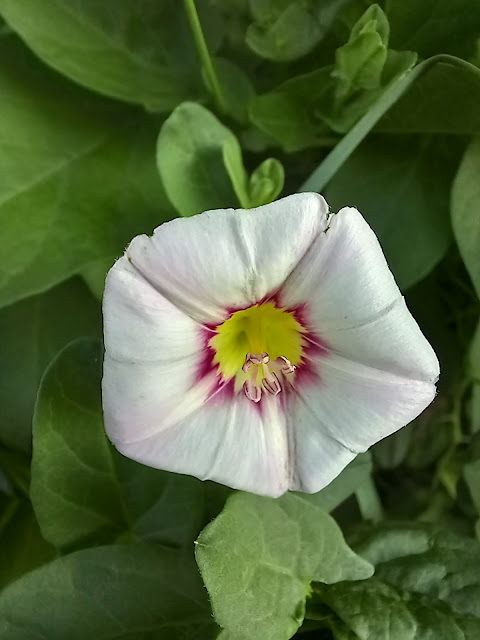Field Bindweed (Convolvulus arvensis)
Some studies of the beautifully varied flowers of Field Bindweed (Convolvulus arvensis, Sw: Åkervinda), the small scrambling bindweed of verges and of fields bleached by herbicide.
Very common in most of the British Isles, but less so in moors and mountains (e.g. most of Scotland).
Worldwide distribution: a broad sweep across Europe and much of temperate Asia, now also well established across North America.
Common in the southern half of Sweden, occasional in the north.
Bindweed
There is little I can do
besides stoop to pluck them
one by one from the ground,
their roots all weak links,
this hoard of Lazaruses popping up
at night, not the Heavenly Blue
so like silk handkerchiefs,
nor the Giant White so timid
in the face of the moon,
but poor relations who visit
then stay. They sleep in my garden.
Each morning I evict them.
Each night more arrive, their leaves
small, green shrouds,
reminding me the mother root
waits deep underground
and I dig but will never find her
and her children will inherit
all that I’ve cleared
when she holds me tighter
and tighter in her arms.
Like some other bindweed poems, this one is fascinated by the plant's famously deep roots, by this image of the ineradicable.
"in the face of the moon". Species such as Hedge Bindweed (Calystegia sepium) keep their flowers open all through a moonlit night.
I never quite like the comparison of living plants to fabrics ("handkerchiefs", "shrouds"). I can't ignore my feeling of how different they are; how fabric, like most other human artefacts, is essentially arid, while plant tissue is essentially water-based.
The more natural comparison, in that respect, is to the animal body. But this leads to other difficulties. For instance, bindweed is often said to "choke" other plants. But that's a bit misleading; plants don't have lungs or throats or windpipes.
The aggressive connotation seems a bit awry, too. It competes, of course. But more often than not, Convolvulus arvensis is found intergrowing with other plant species in a community: other plants of high summer, or the relics of spring plants that do all their work before the bindweed begins to show. When you see it unaccompanied by other species, it's usually on ground that other plants can't cope with, such as gravel or sand.
The lateral scrambling has a different function than stifling other vegetation. Field Bindweed is emphatically a full-sun plant. The scrambling gives it the option, denied to most other plants, of shifting its position a long way sideways from the spot where it happens to germinate, and thus to find its place in the sun.
Still, there's something animal about the scrambling habit of Field Bindweed; perhaps its reach, the sense of horizontal travel. So maybe it feels right when, in Alice Oswald's poem "Body", a badger, clinging to life,
with that
bindweed will of hiswent on running along the hedge andinto the earth again
The tangled bine-stems scored the skyLike strings of broken lyres
The cumbrous bind-weed, with its wreaths and bells,Had twined about her two small rows of peas,And dragged them to the earth.
Labels: Alice Oswald, James McKean, Thomas Hardy, William Wordsworth
















0 Comments:
Post a Comment
<< Home